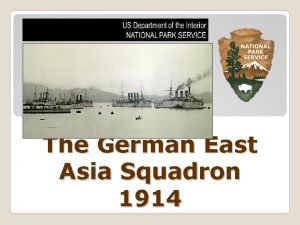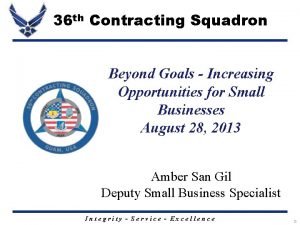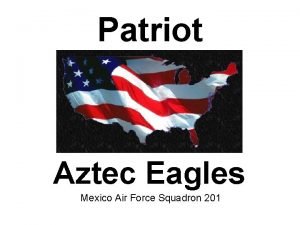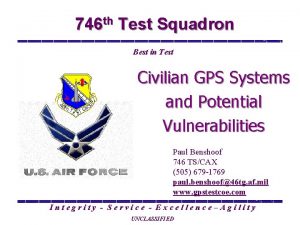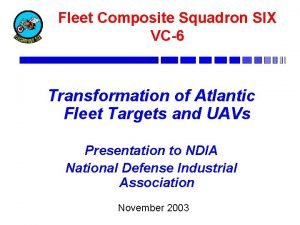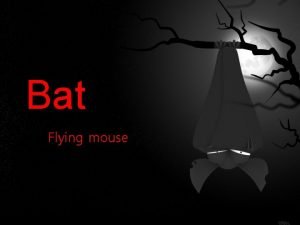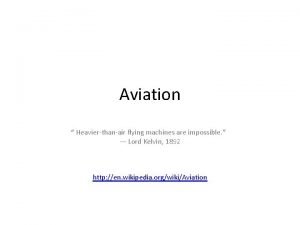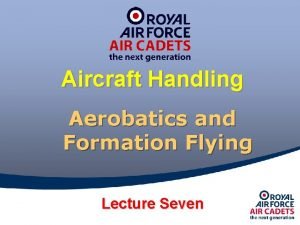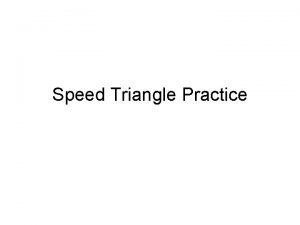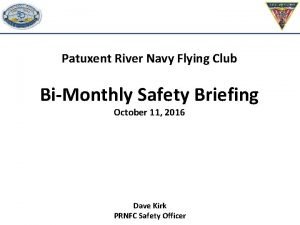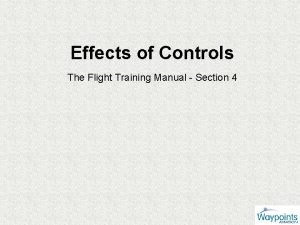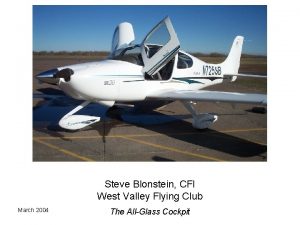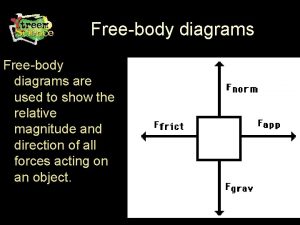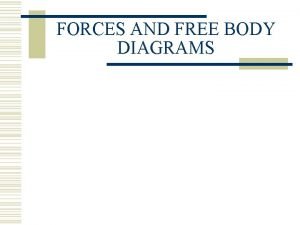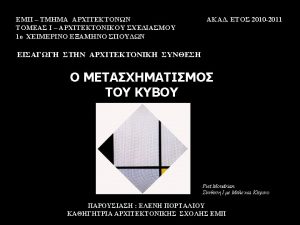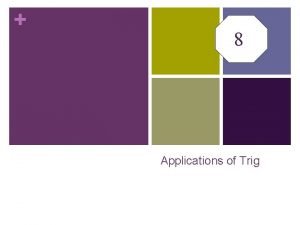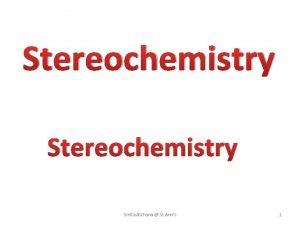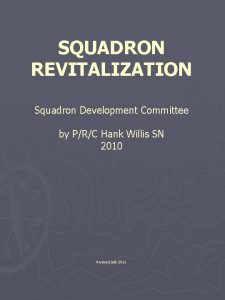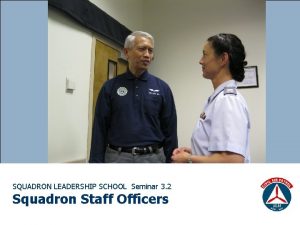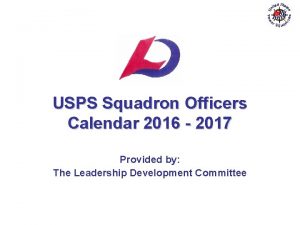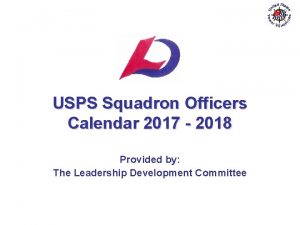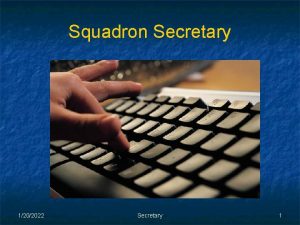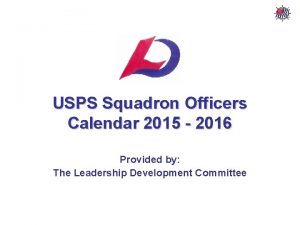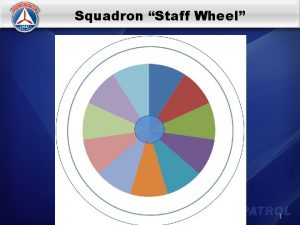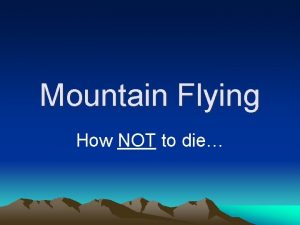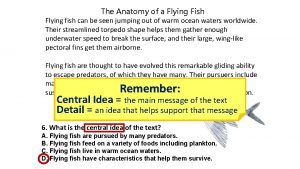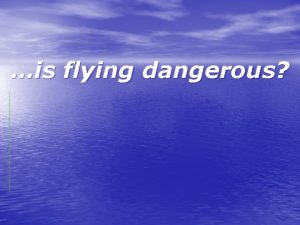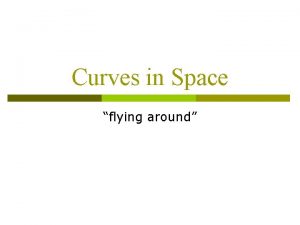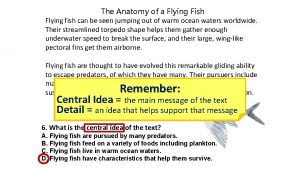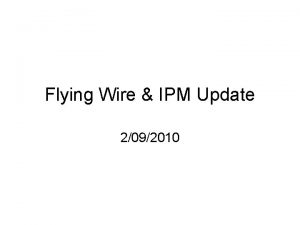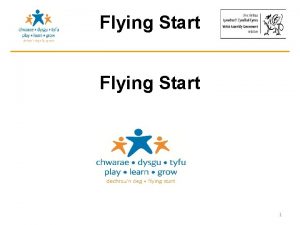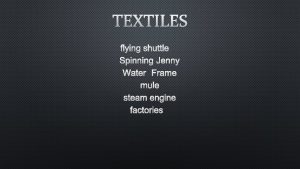86 th Flying Training Squadron 1 Flying Training






















- Slides: 22

86 th Flying Training Squadron #1 Flying Training Squadron in the World T-1 Formation and Mission Familiarization Briefings Integrity - Service - Excellence 1

Overview • Air Force Instructions and General Knowledge Sources • Formation • Air Refueling • Air Drop 2

Instructions and GK Sources • • • AFI 11 -202 V 3 AFI 11 -2 T-1 V 3 AFMAN 11 -247 LAFBI 11 -201 86 FTS OI 11 -101 • Volume three • Formation standards and communication guides • IFG • FAR/AIM • AP 1/B 3

Formation • Mission Planning • Crews should coordinate with each other to ensure required syllabus items are planned and maneuver continuity is taken into account (i. e. wing takeoff requirements, MIF items, special syllabus, etc. ). • Formation maneuvering usually takes place in Burr MOA. If a different MOA is required, sign out airspace at duty-desk. • Sign out formation call signs on sheet located near FCIF cards. • Determine formation commander and individual aircraft commanders (see 86 FTS OI 11 -101). 4

Formation • Mission Planning (continued) • Create mission card (use standard 86 FTS mission card) and make copy for each crew member. • Flight plan • Usually file one flight plan; however, separate flight plans may be required if weather or mission requirements dictate. • If weather requires single ship clearances on departure/recovery, separate flight plans may be required/preferred. • Reference GP, 86 FTS OI 11 -201, and IFG. • PFPS Form 70 is required for each sortie. • Know 86 FTS OI 11 -201 Formation Standards and Formation Communications Guide. • Student in the lead aircraft briefs the mission using the Formation Briefing Guide in the IFG. 5

Formation • Ground Ops • • Student sits in right seat Inform lead/wing of any delays during ground ops Inform crew chief of formation mission Taxi no closer than 150 feet from lead (approximately 2 taxi lights behind) • Minimum runway width formation takeoff is 150 feet • If crosswind component exceeds 10 knots, place wingman on upwind side of runway 6

Formation • Takeoff/Departure • Types of formation takeoffs • 15 second interval takeoff • One minute interval takeoff • Feed-on takeoff • On departure, passing 400’ or 1, 500’ AGL, lead reduces power to MCT minus 5% N 1. After wingman rejoins, lead sets MCT minus 2% N 1. • Standard Formation • Wingman remains within 1 mile laterally and within 100 feet vertically of lead • Nonstandard Formation • Request with ATC • See LAFBI 11 -201 for enroute to MOA procedures • Visual Position vs. Offset Position 7

Formation • Visual Formation • Wingman approximately 600 -700 feet aft of lead & 200 -300 feet laterally References • Read letters on tail easily • Barely make out the #s • . 2 DME on A/A TACAN • Barely see front cockpit windows • Right engine on lead’s emergency exit door • Stinger light just touches left engine 8

Formation • Offset Position • Wingman 600 -4000 feet (. 2 -. 8 DME) from lead • Remain within semi circle starting from abeam lead 9

Formation • Area Maneuvers • • Offset maneuvering Straight ahead rejoin Turning rejoins Practice lost wingman Breakout Cell Position change Note: information on techniques for accomplishing area maneuvers is found in the online instructor guide. 10

Formation • Destination Arrival • Drag procedures • Initial/tactical overhead pattern • Downwind entry 11

Air Refueling • Mission Planning • Reserve airspace through 86 FTS Duty Desk or appropriate agency (AR 650, AR 614, AR 1/2). Schedule track for at least 15 minutes prior to the ARCT. • Crews should coordinate with each other to ensure required syllabus items are planned and maneuver continuity is taken into account (i. e. overrun/breakaway requirements, MIF items, special syllabus, etc. ). • Plan 2 rendezvous (breakaway after each) and a complete set of formation maneuvers following the air refueling training. • Determine formation commander and individual aircraft commanders (see 86 FTS OI 11 -101). 12

Air Refueling • Mission Planning (continued) • Create mission card (use standard 86 FTS mission card) and make copy for each crew member. • Flight plan. • Must file two separate flight plans since aircraft are departing single ship. • Reference GP, 86 FTS OI 11 -201, and IFG. • Get an accurate time hack prior to the briefing (DSN 762 -1401). • Know 86 FTS OI 11 -201 Formation Standards and AR Communications Guide. • Devise and brief a clear plan for use and management of UHF and VHF frequencies/radios. Only use AR specific frequencies during time AR track is reserved. If outside the reserved track time, use formation comm plan frequencies • Student flying in tanker aircraft first briefs the mission using the Formation Briefing Guide in the IFG 13

Air Refueling • Ground Ops • Student sits in right seat. • Single ship ground ops (you are not a formation yet). • Inform other aircraft if timeline can not be met (i. e. maintenance problem). • Tanker is responsible for coordinating changes to airspace and timeline requirements. • Any change to the Air Refueling Control Time (ARCT) should be completed prior to takeoff. • During Flight (Prior to Rendezvous Completion) • New checklists to accomplish (See AR section in IFG). • Extensive use of FMS and A/P required. Learn it early. • MARSA: Military Assumes Separation of Aircraft. • Requirements to accept MARSA: positive ID, positive radio contact and altitude separation. • Precontact and Contact Positions 14

Air Refueling Precontact 15

Air Refueling Contact 16

Air Refueling • Break-up • Complete a practice emergency separation (i. e. breakaway) after final contact. • Accomplish altitude swap when 1000’ vertical and 3 NM lateral separation achieved. • Reverse roles and complete 2 nd rendezvous. • MOA Formation Work • May need to move from AR airspace to MOA form work. • Do a full formation maneuver profile following the AR training (time permitting). • Formation Arrival • Plan a formation arrival to destination airfield (wx permitting). • Drag procedures. • Initial/tactical overhead pattern. • Downwind entry. 17

Air Drop • Mission Planning • Reserve low levels through 86 FTS Duty Desk. See LAFBI 11201 and/or IFG for local IR, SR, VR low level scheduling information. • Crews should coordinate with each other to ensure required syllabus items are planned and maneuver continuity is taken into account (i. e. wing takeoff requirements, IR vs SR requirements, MIF items, special syllabus, etc. ). • Sign-out air drop low level charts from Check Flight. • Update/chum charts. 18

Air Drop • Mission Planning (continued) • Determine formation commander and individual aircraft commanders (see 86 FTS OI 11 -201). • Create mission card (use standard 86 FTS mission card) and make copy for each crew member. • Flight plan. • Usually file one flight plan; however, separate flight plans may be required if weather or mission requirements dictate. • Reference GP, 86 FTS OI 11 -201, and IFG. • AHAS/BAM level may impact low level and air drop altitudes. • Get an accurate time hack (DSN 762 -1401). • Know 86 FTS OI 11 -201 Formation Standards and Formation/Low Level Communications Guide. • Student in lead aircraft briefs the mission. 19

Air Drop • Ground Ops • Student sits in right seat • Same as formation ground ops. Lead is responsible for coordinating changes to low level entry times. • Controlled takeoff time (CTO). • Enroute to Entry Point • Use FMS route menu to load air drop route. Use of FMS in combination with chart reading is highly encouraged. • Low level entry checklist. 20

Air Drop • Airdrop altitudes on mission card should be in AGL and MSL. • TOT is evaluated to the second. Don’t use FMS clock for TOT (does not display seconds). Use time-hacked watch from brief. • Wingman can use speed brakes during drop if needed. • MOA Work • Do a full formation maneuver profile following the air drop (time permitting). • Formation Arrival • Plan a formation arrival to destination airfield (wx permitting). • Drag procedures. • Initial/tactical overhead pattern. • Downwind entry. 21

Building Tomorrow’s Mobility Leaders for Today’s Armed Forces Integrity - Service - Excellence 22
 German east asia squadron
German east asia squadron Contracting squadron 36
Contracting squadron 36 Squadron 201 aztec eagles
Squadron 201 aztec eagles 746th test squadron
746th test squadron X hsmst
X hsmst Long term impacts of the industrial revolution
Long term impacts of the industrial revolution Bats
Bats Flying shuttle
Flying shuttle Lord kelvin flying machines
Lord kelvin flying machines Hassel checks
Hassel checks Distance speed time triangle
Distance speed time triangle Bow tie quilt pattern meaning
Bow tie quilt pattern meaning Pax river flying club
Pax river flying club Effects of controls flying lesson
Effects of controls flying lesson Flying club management software
Flying club management software Bungee jumping free body diagram
Bungee jumping free body diagram Types of forces and free body diagrams
Types of forces and free body diagrams Flying shuttle
Flying shuttle Broadway boogie woogie 1943, piet mondrian 1872-1944
Broadway boogie woogie 1943, piet mondrian 1872-1944 A bridge is supported by triangular braces
A bridge is supported by triangular braces The flying storehouse
The flying storehouse Z and e configuration
Z and e configuration Attitude instrument flying
Attitude instrument flying
